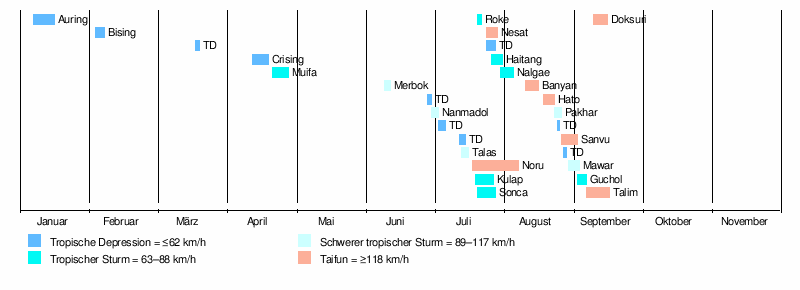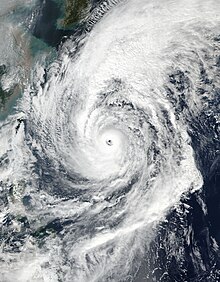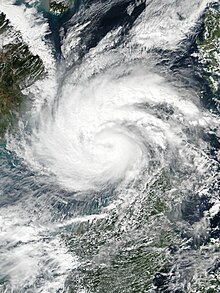Pacific typhoon season 2017
 All the storms of the season | |
| Formation of the first storm |
January 7, 2017 |
|---|---|
| Dissolution of the last storm |
Season active ... |
| Strongest storm | Noru & Talim - 935 hPa ( mbar ), 95 kn (175 km / h ) (10 minutes) |
| Tropical lows | 33 |
| Storms | 21st |
| Typhoons | 8th |
| Super Typhoons (JTWC) | 1 (unofficial) |
| Total number of victims | 238 |
| Total damage | $ 6.61 billion (2017) |
|
Pacific typhoon seasons 2015 , 2016 , 2017, 2018 , 2019 | |
The 2017 Pacific typhoon season was an ongoing weather event that included the tropical cyclones in the Northwest Pacific (west of 180 degrees and north of the equator ) that formed throughout the calendar year . Cyclones in this area are called typhoons , east of 180 ° longitude they are called hurricanes and are the subject of the Pacific hurricane seasons . Tropical cyclones in the South Pacific are called cyclones and are grouped together in the South Pacific Cyclone Seasons and the Australian Cyclone Seasons . Most typhoons form between May and November, hence the annual summary of seasons. However, they also occur regularly at all other times of the year, but less frequently.
Within the northwestern Pacific, there are two meteorological organizations that give names to storms. As a result, the same storm is often given two different names. The official designation by the Japan Meteorological Agency (JMA) is given to a tropical storm as soon as it reaches wind speeds of 35 knots (around 65 km / h) for 10 minutes at any point in the northwestern Pacific . The Philippine Atmospheric, Geophysical and Astronomical Services Administration (PAGASA), on the other hand, assigns names to tropical low pressure areas that develop within the national area of responsibility or move there; this area of responsibility is roughly defined between 115 ° and 135 ° east longitude and between 5 ° and 25 ° north latitude. PAGASA assigns a local name even if the system has already been named by the Japan Meteorological Agency. Tropical depressions that from the US Joint Typhoon Warning Center are observed, get a number with the suffix W .
Season forecasts
| TSR date |
ACE | tropical storms |
all typhoons |
intense typhoons |
Ref. |
|---|---|---|---|---|---|
| Average (1965–2016) | 297 | 26th | 16 | 9 | |
| 5th May 2017 | 357 | 27 | 17th | 10 | |
| regional forecast date |
Forecast center |
period | Systems | Ref. | |
| 20th January 2017 | PAGASA | January-March | 1-2 | ||
| 20th January 2017 | PAGASA | April June | 2-4 | ||
| actual activity |
Forecast center |
tropical systems |
tropical storms |
Typhoons | Ref. |
| JMA | 5 | 1 | 0 | ||
| JTWC | 3 | 1 | 0 | ||
| PAGASA | 4th | 1 | 0 | ||
During the year, several national meteorological services and scientific institutes predict how many tropical depressions, tropical storms, and typhoons will form during the season and / or hit a particular country. These include the Tropical Storm Risk (TSR) Consortium of University College London , PAGASA, and Taiwan's Central Weather Bureau .
PAGASA published the first seasonal forecast on January 20 with its climate forecast for the period January to June 2017. Between January and March, PAGASA expected one to two tropical systems in its area of responsibility and another two to four in the months of April to June. On March 23, the Hong Kong Observatory announced that it expected typhoon season activity in Hong Kong to be fairly normal and that four to seven tropical storm systems would be closer than 500 km to Hong Kong (the average is six such storms per year).
Tropical Storm Risk (TSR) announced its first seasonal forecast on May 5, 2017. Accordingly, the institute expects a slightly above-average season with 27 named storms, of which 17 typhoons and 10 intensive typhoons, and an Accumulated Cyclone Energy (ACE) value of 357.
Season overview

The first half of 2017 was relatively inactive, as only five systems have formed so far, only one of which - Muifa towards the end of April - reached the strength of a tropical storm. The first system was created on January 7th and was named Auring by PAGASA . The Bising Tropical Depression developed in the first week of February, and both depressions were a worsening factor in the Visayas and Mindanao floods in 2017 .
Storms
Talim
Lan

Kai-tak
Tembin

While crossing the island of Mindanao in the south of the Philippines with heavy rain, Tembin had triggered flash floods in the provinces of Lanao del Norte and Sur and destroyed houses built near the rivers in the mountain villages near Tubod and in the city of Piagapo . About 200 people died. The cyclone then followed a comparatively similar trajectory as the devastating Typhoon Linda in 1997 across Palawan and the South China Sea with renewed intensification off the south of Vietnam . Hundreds of thousands were brought to safety in southern Vietnam as a precaution. For a position on December 25 at 8.4N 106.1E the very late for the season typhoon weakened just before Cape Ca Mau (8.4N 104.4E) and the area around the Cape Cà Mau National Park at the southern tip of the Mekong Delta strongly on that Vietnam coast was spared. On December 26th, it slowly migrated as a rainy area into the Gulf of Thailand and was further observed.
Storm names
International names
Tropical cyclones in the western North Pacific are named by the responsible Regional Specialized Meteorological Center in Tokyo of the Japan Meteorological Agency . These are given a name as soon as they reach the strength of a tropical storm. The names come from the following list; this is used continuously, so there are no annually changing lists of names like in the eastern North Pacific or the Atlantic. The names were proposed by the 14 member states of the ESCAP / WMO Typhoon Committee . Each of these members has submitted ten names, which are sorted alphabetically according to the English spelling of these states. The next 30 names on the list were as of January 2017:
|
|
|
|
The names Hato and Lan were used for the first time, replacing the names Washi and Vicente , which were deleted after the typhoon seasons 2011 and 2012, respectively . After the season, the Taifun Committee deleted the names Kai-tak and Tembin from the list of names; Replacement names will be announced in 2019.
Philippines
The Philippine Atmospheric, Geophysical and Astronomical Services Administration (PAGASA) uses its own naming scheme for tropical systems in its area of responsibility. PAGASA's lists of names are reused every four years. These names are given to systems that develop in PAGASA's area of responsibility between 115 ° and 135 ° east longitude and between 5 ° and 25 ° north latitude or migrate into this area. If the list of names proves to be insufficient, the names are taken from a replacement list. This is the same list used in the 2013 season, only the names of the 3 most destructive storms of 2013 Labuyo, Santi and Yolanda have been replaced with Lannie, Salome and Yasmin:
|
|
|
|
|
Web links
- Japan Meteorological Agency
- China Meteorological Administration
- National Weather Service Guam
- Hong Kong Observatory
- Korea Meteorological Administration
- Malaysian Meteorological Department
- Philippine Atmospheric, Geophysical and Astronomical Services Administration
- Taiwan Central Weather Bureau
- TCWC Jakarta
- Thai Meteorological Department
- Vietnam's National Hydro-Meteorological Service
- Joint Typhoon Warning Center
- Digital Typhoon - Typhoon Images and Information
- Typhoon2000 Philippine Typhoon website
supporting documents
- ^ Gary Padgett: Monthly Global Tropical Cyclone Summary May 2003 ( English ) Australian Severe Weather. Retrieved December 29, 2013.
- ↑ a b c Mark Saunders: Extended Range Forecast for Northwest Pacific Typhoon Activity in 2017 ( English , PDF) Tropical Storm Risk Consortium. May 5, 2017. Retrieved May 5, 2017.
- ↑ a b c Vicente B. Malano: January - June 2017 ( English ) In: Seasonal Climate Outlook . PAGASA. January 20, 2017. Archived from the original on February 1, 2017. Retrieved January 29, 2017.
- ↑ Shun Chi-ming: Director of the Hong Kong Observatory highlights Observatory's latest developments March 23, 2017 ( English ) Hong Kong Observatory. March 23, 2017. Retrieved April 14, 2017.
- ↑ 230 deaths from tropical storm Tembin , tagesschau.de , December 24, 2017.
- ↑ Tembin spared Vietnam , tagesschau.de , December 26, 2017.
- ↑ http://www.usno.navy.mil/NOOC/nmfc-ph/RSS/jtwc/warnings/wp3317web.txt
- ^ Gary Padgett: Monthly Global Tropical Cyclone Summary December 1999 ( English ) Australian Severe Weather. Retrieved December 29, 2013.
- ↑ List of Names for Tropical Cyclones adopted by the ESCAP / WMO Typhoon Committee for the Western North Pacific and the South China Sea ( English ) Japan Meteorological Agency. Retrieved January 12, 2017.
- ↑ Replacement Names of HAIMA, SARIKA, NOCK-TEN and MERANTI in the Tropical Cyclone Name List ( English ) ESCAP / WMO Typhoon Committee. February 21, 2018. Retrieved February 24, 2018.
- ^ Tropical Cyclone Information ( English ) PAGASA. Archived from the original on December 22, 2015. Info: The archive link was automatically inserted and has not yet been checked. Please check the original and archive link according to the instructions and then remove this notice. Retrieved January 12, 2017.


